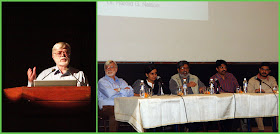One and a half years on, looking back at the stats of visits, visitors and page views on the Design for India blog.
Prof M P Ranjan’s papers

Image 1: Graph of visits, visitors and page views on the Design for India blog over the past 18 months.
As the year 2008 winds down with a sharp fear of worldwide recession that has been sweeping the global financial markets we have a chance to look back at the year that was in the context of this blog about Design for India. Design it seems is drawing growing attention from around the world and in particular Design for India has shown a growing trend in terms of visits, visitors and page views that have been clocked over the past 18 months that this blog and its visitors have been actively monitored across a few parameters of interest.

Image 2: Visits to Design for India from 115 cities across India.
Where do the visitors come from?
The single largest block is from India and I am happy for that since it tells me that interest in design is growing in India and that internet users too are getting to visit a site about Design for India. However it is a bit disturbing that most of these visits are from the major metros although there is still an unaccounted set that could be coming from small towns these do not show up in the Google Analytics view of cities from which the traffic is seen. 115 cities in India have accounted for 23,878 visits and bulk of these came from Ahmedabad, Delhi, Bangalore, Mumbai, Chennai and Hyderabad. Going down the list of cities it is gratifying to see small towns in remote areas listed and we do hope that the message from this blog will reach more schools and workplaces across India where it really matters in the year ahead.

Image 3: Visits from 52 regions of the USA.
The second biggest block of visits comes from the USA and all 52 Regions have shown visitor traffic of 8268 visits and here California, New York, Illinois, Texas and Florida rake in the major share as the top five regions for visitors to the Design for India blog. These 52 regions include as many as 1943 cities with Los Angles and its suburbs, New York, San Francisco and Chicago contributing the largest number of visitors from the USA.

Image 4: Visits from 153 countries across the world with India and USA as top sources of visitor traffic to this blog.
The worldwide picture is also showing some interesting statistics. 42,511 visits have come from 153 countries with India topping the list at 23,878 visits, USA at 8,268, UK at 1,738, Canada at 744, Australia 578, Germany, 480, France, 384 followed by Italy, Netherlands and Switzerland. The city count amongst the top countries are as follows: UK from 296 cities, Canada from 127 cities, Germany from 149 cities and France from 121 cities, and so on.
The top pages visited are listed below and in all 72,071 page views have been recorded across the 105 articles posted on this blog over the past 18 months.
1. Mayo Clinic Sparc and IDEO Design – 1,186
2. Ginger: Design of Smart Hotel Chain – 1,169
3. Herman Miller and Vitra in India – 1,157
4. Bamboo Mat Boards from IPIRTI - 948
5. LEGO: Toy for all ages - 926
6. Rainwater Harvesting: FURAAT Systems - 919
7. Handmade in India: Handbook of crafts of India - 910
8. Charles and Ray Eames: Legacy in India - 908
9. Jewellery and Retail sectors in India - 832
10. Making of Design Entrepreneurs in India. - 668
11. KaosPilot: A Business School that teaches Design - 651
12. IFA: Bamboo exhibitions in Stuttgart and Berlin - 643
I look forward to an active period of design use ahead in 2009 that starts from tomorrow and I wish all the visitors a
Very Happy New Year
We also wish that this kind of design use will be supported by sustainable models which is the theme for the World Economic Forum in January 2009 at Davos for which we have just concluded a series of workshops and charettes on sustainability through which we hope to reach out to the policy makers in industry and governments across the world. Design for India and design from India will, I hope, make an impact across the world in the days ahead.
Prof M P Ranjan’s papers






